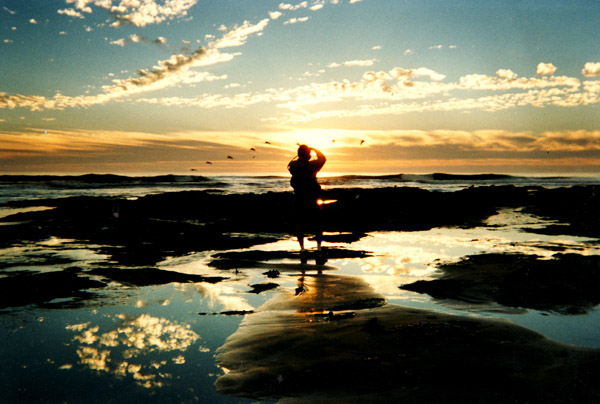
My former girlfriend’s photo, taken with an $8 cardboard disposable camera at a beach just north of Santa Cruz.
I was at Swami Kriyananda’s for a meeting many years ago – the subject escapes my memory. This was sometime in the early 1990s.
I arrived early and Swamiji chatted with me in his gracious way. He told me that a woman in Arizona had offered to pay him to take photos of her guest retreat. Finding himself free of other engagements, he accepted the assignment as a way to raise money for Ananda.
He said that the woman had liked his photos. He chuckled, “It was easy!”
I smiled in response, feeling that I understood his meaning. For many years I had made a special effort to give my photography to God, and to practice His presence while taking pictures.
Before I discovered Ananda and moved to Ananda Village, I worked for a publishing company in the San Francisco Bay Area, where my job included sports photography. My employer published magazines on swimming, soccer, running, martial arts, gymnastics, and bicycling. Most of my photography was for Runner’s World, which the publisher had started while he was in high school, printing it on a mimeograph machine he had bought for $75. When he sold Runner’s World, for a reported $3 million, it had become an international magazine with a dozen employees and 100,000 subscribers.
When I took the job, in 1972, I was passionate about photography as a spiritual practice. On weekends, I would drive to Golden Gate Park in San Francisco and park my 1972 VW Beetle, then set out for a run of fourteen to seventeen miles.
I was a nut-brown boy. I loved running mile after mile, wearing the barest essentials, just shorts and shoes. I delighted in running as primitively as possible, as I imagined native people had done thousands of years before. I even declined to carry my car keys, those unwelcome reminders of “civilization,” hiding them under leaves beneath the car.
This was the life! – stripped to the basics and padding along the ocean, then circling Lake Merced and returning to explore the woodsy trails of Golden Gate Park.
Afterward, I would linger in the park or drive to a different part of the city, generally downtown or the beach, and walk for hours with my camera.
I practiced a strict spiritual discipline. I prayed to God, over and over: “You are the camera. You are the film. You are my perceptions. You are the inspiration. Use me to take the pictures You want to take.”
I kept up a constant stream of prayer, fearful lest I be even slightly distracted. Later, I would learn to be more relaxed while opening myself to receive God’s inspiration. But I wanted to be sure there was no part of me that I wasn’t offering.
As I’ve mentioned elsewhere, a photo would sometimes “take itself.” Before I had registered the fact, the camera would rise and I would snap the shutter, not sure why I had done so.
They were seldom traditionally beautiful photos. I wasn’t much interested in taking pictures of flowers, sunsets, or pretty faces. I took a photo of a hippie leaning over a railing and staring at the sea. His jacket had the Zig-Zag logo on the back – Zig-Zag was a brand of cigarette papers used to roll marijuana joints. The photo had a quietly mystical feeling – it showed a person pausing by the eternal sea and contemplating an uncertain future. A publisher used it on the cover of a book about drug recovery.
As the years passed, I became increasingly aware that God’s inspiration was always available in even the smallest, seemingly most trivial things.
When I joined Ananda’s legal crew, my “boss” was a superb organizer. He ran a tight ship, and he wanted everything done just right.
The office was a model of efficiency. My boss was a man of good heart, but I could tell that my mistakes got under his skin – he grieved over every minor error. I couldn’t blame him. I’ve always had trouble with small office tasks that are new and unfamiliar, like filling out a delivery form. But I learned that I could generally stay out of trouble if I would take time to pray, “Divine Mother, please help me.”
A saint in India Sri Aurobindo, wrote a book called The Mother, in which he described the qualities of the various manifestations of the Mother aspect of God.
Kali is the mother who gives us power to blast through obstacles and make rapid spiritual progress. In this role, She can be very fierce and uncompromising.
Lakshmi is the mother who presides over the beauty of Her creation. If we want to receive Her vision, the altar must be pristine, the incense pure, the chanting perfectly sweet, and the images angelic.
Then there is Ishwari, the remote and inaccessible Mother who represents the first manifestation of Spirit in creation. Ishwari’s vision, Sri Aurobindo said, is very difficult to obtain.
Of all the forms of the Mother, the one that most attracts me is Saraswati, the goddess of music and learning.
Sri Aurobindo explained that Saraswati is the Mother who attends to the details of our lives. She it is who makes sure Her children don’t leave home without their galoshes and that their lunch boxes are packed and they have clean handkerchiefs.
She is the aspect of the Mother that we can pray to for help in matters that may seem too trivial to warrant God’s attention.
“Ouch, here comes that person with whom I have no fellow-feeling and who I suspect doesn’t even like me. Mother, show me how to behave!”
Through trial and error, I found that it was always wise to pray: “Mother, show me what to do! I want to create harmony in this situation. I want to give Your kindness, love, compassion, friendship, and good cheer.”
“How can I fix a lunch that will give me energy and health, instead of reaching for a quick jolt of starch and sugar?”
Mother Saraswati loves to stand by our side and help us prepare a delicious meal.
No need to visualize a goddess playing a veena with one hand and holding a lotus in another – what does it all mean? Just know that in her bustling motherly form, Saraswati is eager to help us when we call.
I’ve been involved with photography for a little over fifty-eight years. I’ve owned wonderful cameras: top-of-the-line Nikons, Leicas, and Canons. Yet I find that photo gear is never the most important factor in taking good pictures.
A former girlfriend took a lovely photo with a disposable Fuji camera that cost eight dollars. I had the photo printed and hung it on my office wall. (The photo appears above.)
That’s me in the photo. It shows me taking photos with a $3000 Nikon camera and a $1500 lens, and all I got to show for my efforts was some boring photos of pelicans. Meanwhile, my girlfriend took a lovely picture with her cheap little camera and the magic of a warm and quiet heart.
As I’ve mentioned, people would often baulk when Swamiji would point out that Self-Realization is a complete path, offering us all of the resources we need. When he urged us to look no farther than Yogananda’s guidance for answers about our diet, health, relationships, and anything else, he meant it seriously.
In The Joyful Athlete, I offered an answer to a thorny question that we all face when we start an exercise program.
Few athletes can afford to hire a full-time coach to stand by their side. Yet, without an “old hand” to guide us, how can we make wise decisions in the moment? In sports, the wrong decisions can set us on a path to disaster.
Should we read books and rigidly follow the authors’ suggestions? In my experience, it’s a sure recipe for failure. The body changes daily, even hourly, and sticking to an inflexible routine is unwise.
The secret I discovered is that every athlete has a built-in “coach” that can give him the precise guidance he needs.
That coach is intuition – the “still, small voice” of calm inner feeling.
Experienced coaches tell us to “listen to the body.” Yet they never really tell us how. And that’s a shame, because it’s a simple skill, and valuable beyond all measure.
It’s a habit that all successful athletes develop, though often only after many years. Yet it’s easy, if we’re willing to pay attention to what our bodies are trying to tell us.
Over thousands of miles of running, I realized that the subtle feelings of my heart were giving me priceless guidance for what my body could safely and profitably do at every moment.
The body continually speaks to us through the feelings of the heart. When the body is sick, it announces the fact by making us feel lousy. When we are healthy, fit, and well-rested, we feel great. The heart, speaking through inner feeling, can give us precise guidance for our training.
When I began to take those feelings seriously, my running became much more enjoyable and productive.
If we can discipline ourselves to follow the body’s voice, speaking through the feelings of the heart, we will find that it has answers to every question.
The same principle applies in all the other areas of our lives, including the spiritual. The heart is Grand Central Station for many wonderful things.
The difference is that, on the spiritual path, we have not only the voice of the body to guide us. By calming the heart’s feelings in meditation, we find ourselves in touch with a wonderful source of unfailing and infallible guidance. The secret lies in those four words: “calming the heart’s feelings.” Those simple words suggest a discipline that is not easy.
When we do the right thing, as suggested by the calm voice of intuition, we find that its counsel is always liberating. The secret lies in calming our hearts until they are sufficiently receptive and dispassionate to hear what the inner wisdom is trying to tell us.
In my practice of “spiritual” training, I would take a long warmup, during which I would watch the feelings of my heart. Once the body was running smoothly, I would speed up tentatively and see what my feelings were telling me. If there was a subtle sense of rightness, I might increase the pace and hold it for as long as the feeling of harmony and rightness persisted.
I found that no question was too small to ask for God’s help. “Master, how should I arrange my diet?” “Master, what can I do about this injury?” “Master, help me to train in a way that will please God.” In every situation, I found that inviting the higher guidance led to the greatest happiness and success.
